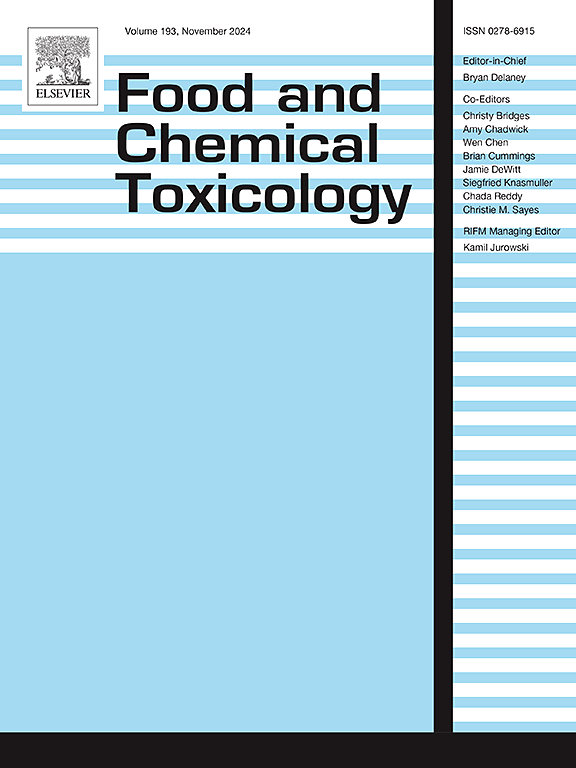Cr (VI) induces lactate utilization through HIF-1α/MCT1 dependent on p53 protein level
IF 3.9
3区 医学
Q2 FOOD SCIENCE & TECHNOLOGY
引用次数: 0
Abstract
Hexavalent chromium [Cr (VI)] is a known environmental pollutant, which promotes tumorigenesis. Hypoxia-inducible factor-1α (HIF-1α) is crucial for cancer development. Here, we found that Cr (VI) treatment promoted lactate utilization by increasing monocarboxylate transporter 1 (MCT1) and monocarboxylate transporter 4 (MCT4) expression, while increasing the expression of HIF-1α in A549 cells but reducing HIF-1α and MCT1 in HELF cells. CoCl2, an HIF-1α inducer, increased MCT1, while the HIF-1α inhibitor YC-1 and MCT1 inhibitor AZD3965 suppressed Cr (VI)-induced lactate utilization and cell growth. Chromatin immunoprecipitation (ChIP) assay revealed HIF-1α bound to the MCT1 promoter to enhance its transcription. Using Reactivating p53 and Inducing Tumor Apoptosis (RITA), which can increase the protein level of p53, we discovered that the low level of p53 protein in A549 cells determined the effect of Cr (VI)-induced HIF-1α. These findings highlighted the role of p53 protein level in the effects of Cr (VI) on HIF-1α/MCT1 to induce lactate utilization and cell growth. Targeting the p53/HIF-1α/MCT1 pathway could inhibit Cr (VI)-mediated tumorigenesis.

Cr (VI)通过HIF-1α/MCT1诱导乳酸利用,依赖于p53蛋白水平
六价铬[Cr (VI)]是一种已知的促进肿瘤发生的环境污染物。缺氧诱导因子-1α (HIF-1α)在癌症发展中起着至关重要的作用。在这里,我们发现Cr (VI)处理通过增加单羧酸转运蛋白1 (MCT1)和单羧酸转运蛋白4 (MCT4)的表达来促进乳酸的利用,同时增加A549细胞中HIF-1α的表达,而降低HELF细胞中HIF-1α和MCT1的表达。HIF-1α诱导剂CoCl2增加MCT1,而HIF-1α抑制剂YC-1和MCT1抑制剂AZD3965抑制Cr (VI)诱导的乳酸利用和细胞生长。染色质免疫沉淀(ChIP)分析显示HIF-1α与MCT1启动子结合,增强其转录。利用可提高p53蛋白水平的Reactivating p53 and Inducing Tumor Apoptosis (RITA),我们发现A549细胞中p53蛋白的低水平决定了Cr (VI)诱导HIF-1α的作用。这些发现强调了p53蛋白水平在Cr (VI)对HIF-1α/MCT1诱导乳酸利用和细胞生长的影响中的作用。靶向p53/HIF-1α/MCT1通路可抑制Cr (VI)介导的肿瘤发生。
本文章由计算机程序翻译,如有差异,请以英文原文为准。
求助全文
约1分钟内获得全文
求助全文
来源期刊

Food and Chemical Toxicology
工程技术-毒理学
CiteScore
10.90
自引率
4.70%
发文量
651
审稿时长
31 days
期刊介绍:
Food and Chemical Toxicology (FCT), an internationally renowned journal, that publishes original research articles and reviews on toxic effects, in animals and humans, of natural or synthetic chemicals occurring in the human environment with particular emphasis on food, drugs, and chemicals, including agricultural and industrial safety, and consumer product safety. Areas such as safety evaluation of novel foods and ingredients, biotechnologically-derived products, and nanomaterials are included in the scope of the journal. FCT also encourages submission of papers on inter-relationships between nutrition and toxicology and on in vitro techniques, particularly those fostering the 3 Rs.
The principal aim of the journal is to publish high impact, scholarly work and to serve as a multidisciplinary forum for research in toxicology. Papers submitted will be judged on the basis of scientific originality and contribution to the field, quality and subject matter. Studies should address at least one of the following:
-Adverse physiological/biochemical, or pathological changes induced by specific defined substances
-New techniques for assessing potential toxicity, including molecular biology
-Mechanisms underlying toxic phenomena
-Toxicological examinations of specific chemicals or consumer products, both those showing adverse effects and those demonstrating safety, that meet current standards of scientific acceptability.
Authors must clearly and briefly identify what novel toxic effect (s) or toxic mechanism (s) of the chemical are being reported and what their significance is in the abstract. Furthermore, sufficient doses should be included in order to provide information on NOAEL/LOAEL values.
 求助内容:
求助内容: 应助结果提醒方式:
应助结果提醒方式:


